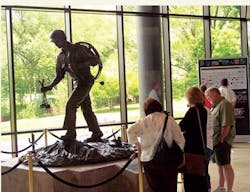Believed to be about 40,000 years old, the "Lion Man" from the Swabian Alps in Germany is widely accepted as the world's oldest known statue. The discovery of the Lion Man dates to August 1939, when fragments of mammoth ivory were excavated at the back of the Stadel Cave in the Swabian Alps.
When the statue was eventually reassembled in 1970, it was regarded as a standing bear or big cat—but with human characteristics—according to The Art Newspaper. It was recently thought to be 32,000 years old but with the discovery of new pieces, the statue's age has been refined using radio-carbon dating of other bones found in the strata and reveals a date of 40,000 years ago.
After reading a story about the Lion Man, this editor became curious about statues symbolic to the oil and gas industry.
Landmarks
"The Golden Driller" is a 43,500 lb, 76 ft statue of an oil worker. It is the largest free-standing statue in the world, and the fourth-tallest statue in the US. It was first erected by Mid-Continental Supply Co. at the 1953 International Petroleum Exposition. The Driller received such favorable reviews that it was temporarily brought back for the 1959 show.
The company donated the statue to the Tulsa County Fairgrounds Trust Authority. In 1979, the Driller was adopted as the state monument. A plaque at the base of the monument reads: "The Golden Driller, a symbol of the International Petroleum Exposition. Dedicated to the men of the petroleum industry who by their vision and daring have created from God's abundance a better life for mankind."
In Wyoming, "Man Made Energy," also known as the "Welcome to Casper Eastside Gateway Monument," depicts four prominent local oil men—Dave True, John Wold, Mick McMurry, and Fred Goodstein—working on the floor of a drilling rig. Sculpted by Seth Vandable, this statue is symbolic of the dedication and hard work required to extract oil and gas.
Methods and tools
While browsing the American Oil & Gas Historical Society's web site, this editor learned about the "Doodlebugger." The name is a badge of honor among geophysical crews searching for petroleum. SEG's journal, Geophysics, which first appeared in 1936, included articles about the petroleum industry's three major prospecting methods then known: seismic, gravity, and magnetic. The lead article warned young geophysicists about employing black magic or doodle-bug methods based on unproven properties of oil, minerals, or geological formations.
The Doodlebugger was unveiled during a May 2, 2002, ceremony. The bronze statue, created by sculptor Jay O'Melia, stands almost 10 ft and weighs more than 600 lb.
O'Melia also created an "Oil Patch Warrior" statue of a roughneck dedicated in 1991 in Sherwood Forest near Nottingham, England. The 7-ft bronze statue honors American oil men who drilled more than 100 wells there during World War II. A replica of the Oil Patch Warrior was dedicated in 2001 in Memorial Square in Ardmore, Okla., where many of the US roughnecks volunteered for the secret project.
"The Roughneck" at Texas A&M University in College Station is a bronze statue depicting an oil field worker using a chain to control a 20-ft drill pipe and tricone rotary drill bit, incorporating tools of the trade. This piece was commissioned to commemorate the dedication of the Joe C. Richardson Petroleum Engineering Building.
These statues keep this editor interested in what will be sculpted next to represent the future of the industry.
About the Author
Leena Koottungal
Survey Editor / News Writer
Leena Koottungal is the Survey Editor/News Writer for Oil & Gas Journal. She joined PennWell in April 2006.

